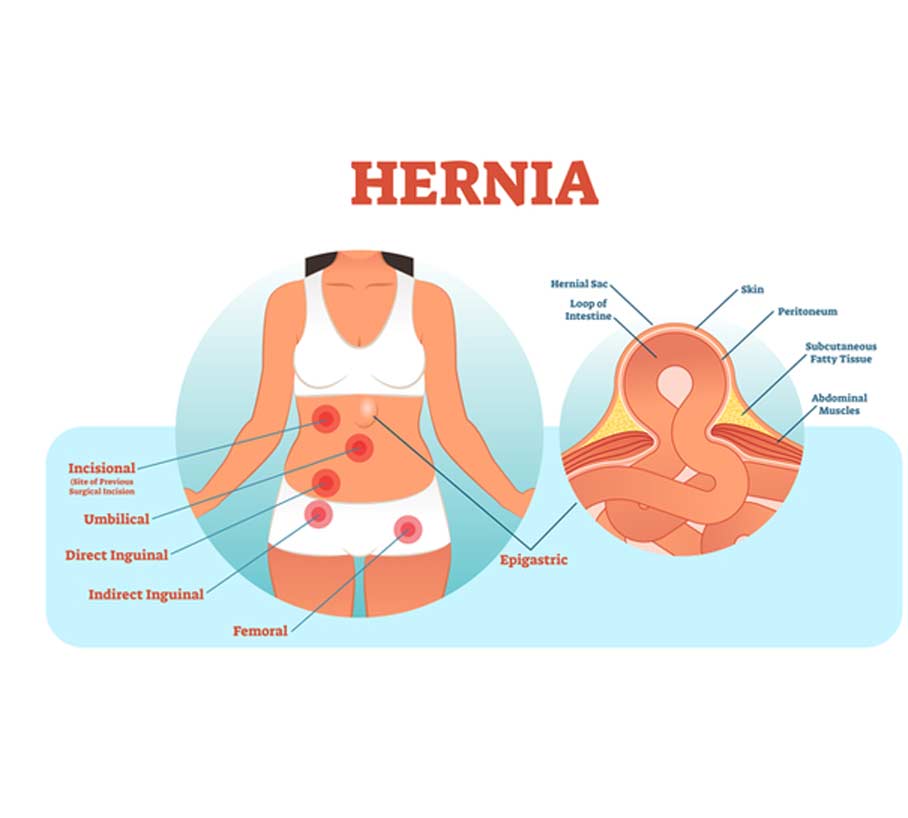Femoral Hernia

When muscles weaken within certain areas of the body, it’s possible that you will suffer from a hernia, which occurs when tissues or organs bulge through an opening.
For instance, it’s common for the intestines to bulge through the abdominal wall. Another standard hernia is a femoral hernia, which occurs within the groin and will typically require surgery to properly fix.
Being able to identify the symptoms of a femoral hernia should help you obtain the treatments that you need to recover.
What Is a Femoral Hernia?
A femoral hernia is a type of hernia that takes place around the groin right at the upper portion of the thigh. Unlike some congenital hernias, a femoral hernia will typically develop over a lengthy portion of time and can range from small to large in size. Femoral hernias are oftentimes mistaken for inguinal hernias because of how close the positions of these two hernias are, which means that a specialist will oftentimes need to take a look at the hernia before being able to provide an accurate diagnosis. In less severe cases, the lining of your abdominal cavity will be all that pushes through the wall of the muscle. However, severe cases involve the bulging of intestines through an opening in the muscle.
Types of Femoral Hernias
There are three types of femoral hernias, which include obstructed, incarcerated, and strangulated femoral hernias. An obstructed femoral hernia is one where a portion of the intestine wraps around the hernia, which causes the intestine to bulge out of the muscle. This is a highly painful type of femoral hernia that can result in vomiting and is caused by inflammation. An incarcerated hernia is one where the hernia becomes stuck within the femoral canal and is unable to be properly massaged into the abdomen, which means that it will require surgery to fix. A strangulated hernia results from a blockage of blood supply to a portion of the bowel, which makes this the most severe type of hernia. If this hernia isn’t treated immediately through surgery, it can be life-threatening due to the development of a serious infection.


Causes and Symptoms of This Condition
Any kind of condition or activity that places pressure on or around the groin can cause a femoral hernia. The main causes include coughing, obesity, COPD, heavy lifting, and straining when urinating. The primary symptoms attributed to a femoral hernia typically include nausea, vomiting, abdominal pain, a bulge right beside the groin, and groin discomfort that worsens whenever straining.
Primary Treatment Options
If ever the hernia that you’re suffering from becomes enlarged or causes any kind of symptoms, you’ll likely want to have a surgical procedure performed that will properly remove the hernia. It’s important to understand that hernias can worsen over time, which is why surgery is necessary. The two types of surgery available for femoral hernias include open hernia repair and laparoscopic repair, the latter of which is a minimally invasive procedure that comes with a shorter recovery time.
Sports Hernia Surgery
If pain comes back with a return to previous activities, surgery to repair the affected tissues may be recommended. With traditional open surgery, a single, long incision is made to repair the damaged tissues. Endoscopic surgery is an alternative approach to achieving the same goal that involves smaller incisions and a lighted scope. In some instances, a small groin nerve is cut to further ease discomfort and reduce the risk of ongoing pain after surgery. This separate procedure is referred to as an inquinal neurectomy.
Some people with a sports hernia have lingering discomfort within the inner thigh area that continues after surgery. When this happens, a procedure called an adductor tenotomy may be performed. It involves the cutting of an inner thigh tendon to release tension in the affected area. Re-injury prevention suggestions commonly include paying attention to proper form and technique when getting back to sports, avoiding constipation as much as possible, and maintaining strong and supportive abdominal muscles.

